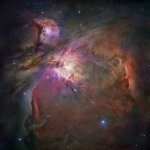Not necessarily. Orbital speed of our solar system within the Milky Way is 1 LY per 1190 years. 4.5 Billion years covers ~3.8 million LY and we have no idea about the relative speed between us and the forming star.... But if the star exploded much later on, then it must still be around close by.
We know Quantum Mechanics is right.
But I do not dismiss many subtleties of Classical Newtonian Mechanics. Lot to learn about Newton and Kepler.
I am following Prof. H.C. Verma right now. Am up to lecture 7. Am particularly fascinated by the Laplace-Runge-Lenz Vector.
https://en.wikipedia.org/wiki/Laplace–Runge–Lenz_vector
This could change everything, IMO. 🙂
But I do not dismiss many subtleties of Classical Newtonian Mechanics. Lot to learn about Newton and Kepler.
I am following Prof. H.C. Verma right now. Am up to lecture 7. Am particularly fascinated by the Laplace-Runge-Lenz Vector.
https://en.wikipedia.org/wiki/Laplace–Runge–Lenz_vector
This could change everything, IMO. 🙂
Attachments
Well no... we don't know Quantum Mechanics is right.
In fact a group of scientists have just proved it to be inaccurate.
When splitting H atoms into quarks and muons, quantum science and probability indicate that they should form in equal proportion.
LHC scientists have discovered that in fact, the distribution of evolved quarks and muons in nothing close to 50:50.
And so, a new force of nature, not accounted for in Quantum Mech, has been discovered.
The next few years QM will be getting a quite a few rewrites
In fact a group of scientists have just proved it to be inaccurate.
When splitting H atoms into quarks and muons, quantum science and probability indicate that they should form in equal proportion.
LHC scientists have discovered that in fact, the distribution of evolved quarks and muons in nothing close to 50:50.
And so, a new force of nature, not accounted for in Quantum Mech, has been discovered.
The next few years QM will be getting a quite a few rewrites
Sounds like you are describing what happens after eating beans and broccoli.
Appropriate enough, given that the description came from an old fart like me! 😊
... star forming regions ...
The nearest star forming region to Earth is the Orion Nebula which is just one of many within our Milky Way Galaxy.
Thousands of stars are forming in the enormous cloud of gas and dust shown in this enhanced Hubble image.
Attachments
And so, a new force of nature, not accounted for in Quantum Mech, has been discovered.
The results from the decay of beauty quarks are indeed unexpected, but it is premature to state that a fifth force of nature "has been discovered".
So far, the results have come within a degree of "error" of about one in 1,000.
Particle physicists refer to this result as being "three sigma" and in practical terms, they are still a way off from confirming their discovery.
A discovery won't be confirmed until the uncertainty in results is narrowed down to five sigma - less than a one in a million chance of the data being a statistical anomaly.
A rather bold statement. You have a differing explanation?Astronomy, than a certain limit is fiction.
There are only theoretical scientists now to create a fake science religion.
Regards.
Actually, we have both theoretical as well as direct measurement cosmologists.
When the theory predicts something and we then go measure the prediction, we have a pretty good idea it is correct, or at least down the right path. When we have measurements with no explanation, we develop theories and then go look for predictions we can test for. In the last decades, the difference between theories and measurements are closer than they have ever been, but that does not mean either are absolutely correct. We knew by theory the W and Z Boson had to be there, It just took about 40 years to measure them. We know by theory, there may be white holes, but we have not found one. That does not mean they are not there, or that they are. It just remains a probability there are. There is good theory for super symmetry, but it has not been observed. ( CERN is working on that)
An interesting example is the unified field theory. I did not know until recently there actually is one that works, but only in 10 dimensions. As we live in 4, we can't currently measure it directly, but we may be able to measure effects that match the predictions. Right now, the "going theory" includes dark matter and dark energy as placeholders for something we measure, but do not understand. There are many other theories of gravity that do not need either. We also are learning that the laws of the cosmos close to the big bang may not be the same laws as post inflation. Theories. Predictions being developed. Then we can look for measurements that confirm or not. Also watch out for theories that do a very good job explaining what we see, but may not actually be correct. Special Relativity may be one such. It works extremely well, but it does have problems.
And OP did ask about the gas.Appropriate enough, given that the description came from an old fart like me! 😊

What if the Big Bang was dipolar in nature? That would put the source at the edge of our universe .. or just beyond it.
Well tbh I am almost verbatim reciting what has been said (actually a radio headline) in the last 3 days.The results from the decay of beauty quarks are indeed unexpected, but it is premature to state that a fifth force of nature "has been discovered".
So far, the results have come within a degree of "error" of about one in 1,000.
Particle physicists refer to this result as being "three sigma" and in practical terms, they are still a way off from confirming their discovery.
A discovery won't be confirmed until the uncertainty in results is narrowed down to five sigma - less than a one in a million chance of the data being a statistical anomaly.
The radio news headlines (could be wrong certainly) stated the decay of beauty quarks as 2:1 or thereabouts proportion of muons and electrons (correcting what I think I got way wrong)
And the scientists are saying that yes its too early to be conclusive, but I think there is quiet confidence.
Of course they just need to repeat etc.
It's a might less scary than the AI assisted fusion experiments/achievement announced in the last week
*and that is as much QM as I care to learn hehe...
But suffice to say, I can agree with the opinion that most science beyond QM are in fact fiction. Educated guesses. Plausible possible explanations. Like many theories.*
And as good science goes, theory will be revised until it better matches reality, or our observation of reality
Last edited:
What if the Big Bang was dipolar in nature?
Can you provide some context for this question in order that it can be fully understood?
You mean post #31?
It has nothing to do with our conversation.
EDIT: I see the reference to a supernova.
It has nothing to do with our conversation.
EDIT: I see the reference to a supernova.
Last edited:
Why do you think that?
The origin of material(s) that created what we perceive as our universe/star/solar system has to be traced back to a singular event.
What if that event occurred outside of our universe? Our search for the root cause wouldn't be able to be completed as proposed by the OP'er.
The origin of material(s) that created what we perceive as our universe/star/solar system has to be traced back to a singular event.
What if that event occurred outside of our universe? Our search for the root cause wouldn't be able to be completed as proposed by the OP'er.
Last edited:
Sorry, puppet, I didn't see the relevance of the Bose-Einstein condensate explosions to what is thought to have happened in the Big Bang.Why do you think that?
Your idea of a "dipolar" Big Bang would appear to describe the emergence of a pair of equal, but somehow opposite, universes separated by a distance.
I don't suppose we can totally eliminate that possibility! 🤔
A star can explode without remnant. See 1a supernova of a white dwarf. This will build a gigantic cloud growing in size for a few millenia. But maybe, eventually, the gravitational force will win and compress it again to form the next generation star.
IIRC,
Nebulae, the nurseries of stars and planets, are formed by a number of reasons, the two biggest factors being stellar decay and supernovae. And yes, there may be 100,000 or more star or star equivalent dust in any nebula. The stars you see within the nebula are either in front of, behind, just passing through or have recently formed within. They don't stay long after they fire up.
Nebulae, the nurseries of stars and planets, are formed by a number of reasons, the two biggest factors being stellar decay and supernovae. And yes, there may be 100,000 or more star or star equivalent dust in any nebula. The stars you see within the nebula are either in front of, behind, just passing through or have recently formed within. They don't stay long after they fire up.
Last edited:
They don't stay long after they fire up.
A star's mass is determined by the amount of dust and gas that is available in its nebula.
The larger its mass, the shorter its life cycle, and vice versa.
If the gaseous material that formed our solar system came from the beginning of the universe, it does not make sense that it would take that long for the gaseous material to form our solar system. The age of the universe is about 15 billion years.that is what i was thinking too.
If you look at the star forming reasons they are huge with old and new stars, and maybe black holes and neutron stars (a good excuse for a pretty picture)

dave
- Home
- Member Areas
- The Lounge
- Where is the star that created earth and our solar system?

